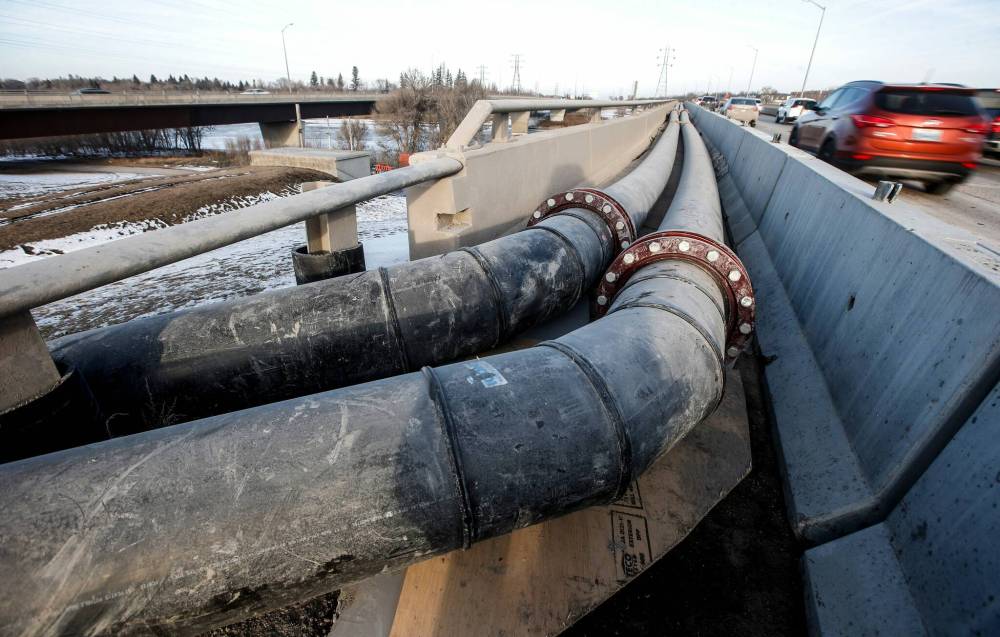Winnipeg’s combined sewer overflows dumped nearly 5.4-billion litres of diluted sewage into local rivers in 2023.
That’s far less than the 27.5-billion litres that spilled in 2022, but city officials say the improvement is largely due to dry weather last year, noting a master plan to reduce the overflows is still in its early stages.
“It was a dry year. The river levels were also lower, so we pumped less (wastewater then.) We had 35 per cent less rainfall in 2023 than (the previous year),” said Cynthia Wiebe, Winnipeg water and waste’s manager of engineering services.

JOHN WOODS / FREE PRESS FILES
City crews work to bypass a sewage leak across the Red River at the Fort Garry Bridge in Winnipeg in February.
The previous year, 2022, was deemed Winnipeg’s wettest year on record.
A city report notes aging combined sewers, which collect precipitation and wastewater in a single pipe, service about one-third of the city. Heavy rain or snow can cause such pipes to overflow.
Wiebe said it’s too soon to tell how much pollution combined sewer overflows will spill into rivers due to wet weather this year, though lower river levels at the start of 2024 could help offset the impact.
“It’s hard to tell because we don’t know what the rest of the summer is going to look like. But what we can say is that the number of (overflows), as well as the volume, are usually related to rainfall,” she said.
The amount spilled by combined sewers has varied widely in recent years, with 5.6 billion litres in 2020 and 10.6 billion in 2021.
The city’s combined sewer overflow master plan aims to capture 85 per cent of overflows, which the city estimates could cost between $1.15 billion and $2.3 billion.
In 2023, the city reached a 76 per cent capture rate, up from 74 per cent in 2013.
Wiebe said the city will produce a water quality report by the end of this year that measures the amount of algae-promoting nutrients in rivers near combined sewer outfalls.
“We’re actually going to be coming out by the end of the year with a water quality report, which we will do every five years (after that)… It’ll measure a variety of nutrients … (including) bacteria, phosphorous,” she said. “What we’re trying to do is measure the impact of our overflows.”
Phosphorous has been identified as one of the key causes of algae growth.
The city has spent more than $192 million on the overflow reduction plan since 2013 and will complete another $242 million of work over the next six years, the report said.
While the municipal government traditionally spent about $30 million per year on the project, council boosted the annual budget to $45 million between 2024 and 2027 to speed up progress.
However, the city has said it won’t complete the project by a Dec. 31, 2045, provincial deadline unless senior governments help fund it. City officials had estimated the master plan would be finished by 2095, if solely funded by the city.
Mayes has repeatedly called for the city to meet the target by 2045 and even consider funding it alone.
“We, as council, have said, ‘Give us the budget to get it done by 2045’… It will come at a cost, but I’m not leaving here with a 2095 completion date for sewer work. That’s not fair to my constituents, that’s not fair to my sons … If I can shave a half a century off that, then I will have accomplished something here, in terms of the environment,” said Mayes (St. Vital).
Winnipeg water and waste director Tim Shanks said a fall water and sewer rate report will estimate the fees that would be required to meet the deadline through municipal funding. Other major sewage updates would also be considered.
“If we don’t find funding elsewhere, we will have to do it on our own and we have to plan for that,” said Shanks.
In January, a city report estimated the average residential customer could pay $624 more over four years to cover $1.15 billion of CSO reduction costs, if the city were to meet the 2045 deadline with no provincial or federal funding. If the cost of the reduction plan reached the upper $2.3-billion estimated price, those customers would pay $1,655 more over four years.
After a few billion litres of diluted sewage spilled into the river during 2023, a comparatively good year, Mayes said the city needs to determine the exact price to get the work done.
“We have invested tens of millions of dollars, so we’re inching toward this capture target… (But) it’s still a problem. It’s still something that I’ve devoted years to try to force a decision (on) here,” he said.
joyanne.pursaga@freepress.mb.ca
X: @joyanne_pursaga

Joyanne Pursaga
Reporter
Joyanne is city hall reporter for the Winnipeg Free Press. A reporter since 2004, she began covering politics exclusively in 2012, writing on city hall and the Manitoba Legislature for the Winnipeg Sun before joining the Free Press in early 2020. Read more about Joyanne.
Every piece of reporting Joyanne produces is reviewed by an editing team before it is posted online or published in print — part of the Free Press‘s tradition, since 1872, of producing reliable independent journalism. Read more about Free Press’s history and mandate, and learn how our newsroom operates.
Our newsroom depends on a growing audience of readers to power our journalism. If you are not a paid reader, please consider becoming a subscriber.
Our newsroom depends on its audience of readers to power our journalism. Thank you for your support.